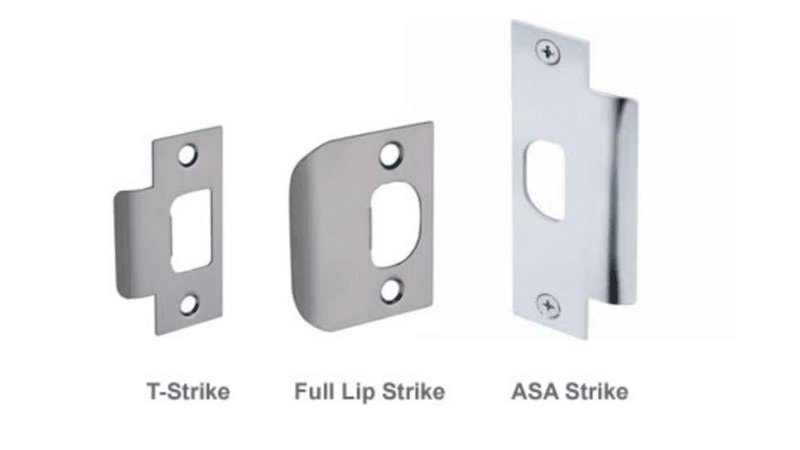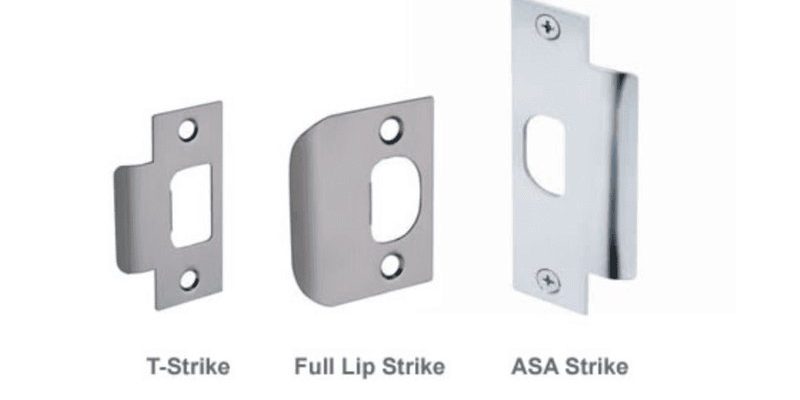
Now, let’s delve deeper. You might have heard of two main types of strike plates—the standard and the full lip. It’s kind of like choosing between a regular-sized pizza and a deep-dish. Both get the job done, but they serve different purposes and fit various preferences. In this article, we’ll explore what these strike plates are, how they work, and why it matters for your home. By the end, you’ll have a clearer picture of which option might be best for your interior doors.
What Is a Strike Plate?
A strike plate is a metal piece installed on the door frame where the latch or bolt of the door locks into place. It’s usually recessed into the door frame and helps prevent damage to the wood from repeated use. By providing a solid surface for the latch to engage with, strike plates enhance the overall security of your doors.
When you close your door, the latch clicks into the strike plate, holding the door in place. Without this little device, the latch could easily wear down or break the frame over time, leading to security issues and potentially costly repairs. So, you might be wondering if all strike plates are created equal. The short answer is no; this is where the differences between standard and full lip strike plates come into play.
Understanding Standard Strike Plates
Standard strike plates are typically rectangular pieces of metal designed to fit flush against the door frame. They are the most common type and work well for many situations. The installation is straightforward; just screw them into the frame where the latch lines up.
One of the main advantages of standard strike plates is their versatility. They can fit various door styles and latch types. However, a potential downside is their size. Because they don’t cover a lot of surface area, they may not provide as much protection against wear and tear over time. If your door is subject to frequent use, you might find that it requires more maintenance.
When considering a standard strike plate, think about where it will be used. They work perfectly in homes where the doors don’t see heavy traffic. However, if your interior doors are always being opened and closed, you might want to consider something a bit sturdier.
Exploring Full Lip Strike Plates
Full lip strike plates take things up a notch. Instead of being straight and rectangular, these plates have a lip that wraps around the edge of the frame. This design offers more surface area for the latch to engage with, providing enhanced security and durability.
The full lip design helps distribute the force of repeated use across a wider area, reducing wear on your door and frame. This makes them an excellent choice for high-traffic areas, like offices or homes with busy families. You’ll find that full lip strike plates can really stand up to the test, helping your door last longer without needing repairs.
Another benefit of full lip strike plates is that they can offer better alignment for latches. If your door is a little misaligned, the lip can sometimes help keep everything in sync, making it less prone to jamming. If you want a strong, reliable option, full lip might just be the way to go.
Key Differences Between Standard and Full Lip Strike Plates
So, what really sets standard and full lip strike plates apart? Let’s break it down with a quick comparison:
| Feature | Standard Strike Plate | Full Lip Strike Plate |
|---|---|---|
| Design | Rectangular | Rectangular with lip |
| Surface Area | Smaller | Larger |
| Durability | Good | Better |
| Use Case | Light to moderate traffic | High traffic areas |
| Installation | Simple | Requires precise alignment |
This table shines a light on the primary features of each type. When choosing between a standard and a full lip strike plate, think about your specific needs. If your door sees a lot of action, full lip could be your best friend!
When to Choose Standard Strike Plates
Standard strike plates might be your best bet in several scenarios. If you have interior doors in rooms that see little traffic—like guest bedrooms or storage areas—a standard plate is often sufficient. They’re budget-friendly and easy to install, which makes them a popular choice for DIYers.
Additionally, if you have a specific aesthetic in mind, standard strike plates often come in various finishes. You can find them in brass, nickel, and even matte black, so it’s easy to match your home’s decor.
Remember, while they’re not as robust as full lip plates, standard plates can still do a solid job if your doors aren’t constantly being slammed open and shut day in and day out.
When to Choose Full Lip Strike Plates
If your interior doors experience heavy traffic, full lip strike plates are likely the smarter choice. Think about the doors leading into kitchens, living rooms, or utility spaces that everyone uses multiple times a day. These areas benefit from the added durability that full lip strike plates provide.
Moreover, if your doors are slightly misaligned—maybe due to settling or wear over time—the lip on the plate can help keep things functioning smoothly. It’s all about making your home work better for you. Plus, since full lip plates come in various styles and finishes, you can still achieve that polished look you want without compromising on functionality.
Finally, if you’re upgrading your home security system, consider investing in full lip plates. These plates provide better anchoring for your door latches, which could add an extra layer of protection against forced entry.
How to Install Strike Plates
Installing a strike plate can seem daunting, but here’s the good news: it’s a straightforward task that you can often do yourself with the right tools. Here’s a quick rundown of the steps:
- Gather Your Tools: You’ll need a screwdriver, a chisel (for precise cuts), measuring tape, and possibly wood filler for any old screw holes.
- Remove the Old Plate: Unscrew your existing strike plate, if there is one. If you’re installing a new one, measure the position where it needs to go.
- Mark and Cut: Use your chisel to make a small recess for the new plate if necessary, ensuring it’s flush with the frame.
- Attach the New Plate: Position the new strike plate over the recessed area and secure it with screws.
- Test the Door: Close the door and check that the latch engages smoothly with the plate.
You might be wondering how difficult this could be. With a little patience and attention to detail, most people find this an easy DIY project. Just take your time, double-check measurements, and you’ll have it done in no time.
Choosing between standard and full lip strike plates boils down to understanding your doors’ needs and your lifestyle. Standard plates may work well for low-traffic areas, while full lip plates shine in busier parts of your home. Think of strike plates as a critical element in your home’s safety and functionality. Investing in the right kind can save you time and hassle in the long run.
When in doubt, assess your doors’ usage and consider your aesthetic preferences. The right strike plate will not only keep your doors secure but also enhance the overall look of your interiors. Now that you know what each type offers, you can make an informed decision that keeps your home safe and stylish.
